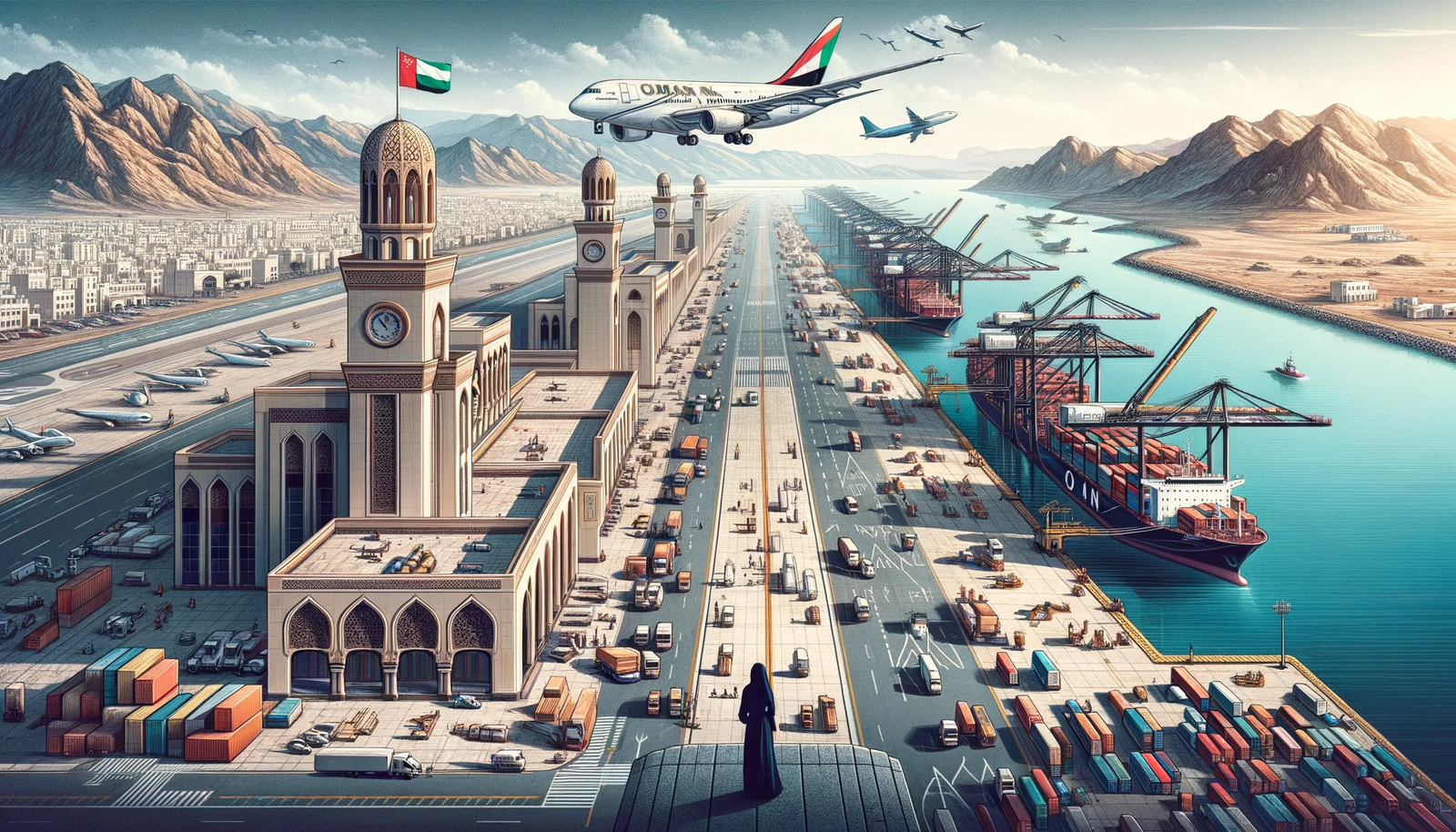Introduction
Oman, strategically located at the crossroads of trade routes between Asia, Africa, and Europe, has long been recognized for its rich history as a trading nation. In recent years, the country has made significant strides in expanding and modernizing its transportation infrastructure, notably its cargo airports and seaports. These developments are transforming Oman into a pivotal hub for global commerce and tourism. This comprehensive guide delves into the role of Oman’s key airports and seaports, highlighting how they serve as vital conduits for international trade and tourism, with a particular emphasis on the increasing influx of Chinese business and leisure travelers. By exploring these gateways, we gain insights into how Oman is leveraging its geographical advantage and state-of-the-art facilities to enhance its position in the global market, while simultaneously captivating the interest of global travelers with its unique blend of ancient culture and modern amenities.
Major Airports in Oman
Oman has been increasingly attracting Chinese tourists and cargo, much like many other Middle Eastern countries. One standout destination in Oman is Muscat International Airport (MCT), a major hub that plays a pivotal role in facilitating tourism and trade between China and Oman. Oman offers a unique vacation experience, with opportunities to immerse in nature through desert safaris, indulge in thrilling activities like kitesurfing, explore enchanting caves, or simply unwind on pristine beaches while relishing the sea breeze. Additionally, shopping in Omani souqs or markets, renowned for their offerings of gold, silver, and textiles, feels like stepping back in time. This blend of natural beauty, cultural richness, and modern infrastructure makes Muscat International Airport the prime choice for those sending cargo from China to Oman by air.
Here is a list of the major international cargo seaports in Oman:
Muscat International Airport (MCT)
Muscat International Airport serves as a multifaceted transportation hub, accommodating both passenger and cargo operations. With a relentless commitment to facilitating efficient cargo logistics, the airport offers an array of state-of-the-art services and facilities. These include 24-hour cargo operations, an automated cargo system for streamlined documentation and processing, and dedicated teams for cargo breakdown and build-up, ensuring that goods flow smoothly to their intended destinations. Muscat International Airport’s cold storage and freezer facilities cater to temperature-sensitive cargo, while specialized areas handle hazardous materials with strict safety measures in place. Moreover, the airport provides separate storage for newspapers, diplomatic mail, and postal mail, guaranteeing secure and efficient handling. Electronic weighing scales and cargo X-ray screening further enhance the accuracy and security of cargo operations. Road feeder services and Freight Status Updates (FSU) messaging requirements support airlines and businesses in seamless cargo transportation. Overall, Muscat International Airport’s cargo facilities are a vital component of its comprehensive logistical offerings, connecting Oman to the world of trade and commerce.
Other Airports in Oman
Here are the other major international airports in Oman:
- Muscat International Airport
- Duqm International Airport
- Salalah Airport Salalah
- Khasab Air Base Khasab
- Sohar Airport
Major Seaports in Oman
Every year, between 5400 and 6200 ships dock in Oman. This is to make sure that this industry does well. This includes 80% of the traffic of large ships that carry cargo from other countries. Most of it is with neighboring Oman, which gives them a trade index of 0.476.
In this article, we look at the five most important ports in Oman and how they are used for trade. We also pay attention to the geography, identification, and handling of cargo. It also has to do with the financial and networking parts of trading.
Port of Salalah
The port of Salalah is a gateway to trade with China, India, Pakistan, Bangladesh, Sri Lanka and other countries in Asia. In order to strengthen ties with these countries, it needs to build up its capacity for import from China as well as export to these countries.
There are a total of 6 large berths in the port of Salalah for moving containers and oil cargo. It has been around since 1998 and has been handling goods at the same time since then. At the moment, the Salalah Port Services are in charge of the building.
A lot of big oil companies and the government both have stakes in the project. So, on average, the terminal has seen between 3.5 and 3.8 million TEU in the last ten years.
The port liner shipping index for Oman is higher than 55. This makes it the fastest terminal in the world for moving containers. The terminal is also sixth on a list of the world’s most efficient port facilities.
In 2017, Salalah handled more than 4 million TEU of containers at its busiest time. Large 25 Post-Panamax 68 and mobile cranes are used in the operations. These range from 60 to 150 MT and are used to move the TEUs when they land at the facility.
The depth of water next to these huge container ships is between 16 and 18.5 meters. This comes from a maneuvering channel that goes as deep as 20 meters. Salalah’s loading speed is also helped by the fact that it has 4-speed loaders.
The building also has 9 forklifts for moving containers of cargo. Also, the cruise terminal in Salalah is a very important part of the city. It sees between 25,000 and 36,000 cruise ship passengers every year.
Port of Sultan Qaboos
The port of Sultan Qaboos is currently in the process of being turned into a cruise port. But as the largest port in the Muscat area, the port has a long history of moving goods. At its busiest, the port and how it worked had 14 places for ships to dock.
At the beginning of the 2000s, the port could handle 820,000 MT of cargo and 250,000 TEU. It has multipurpose berths that range in size up to 458 meters in length. During working days, each of these berths has a working coefficient of 0.75.
Because of pollution and traffic, the port is not being used at all right now. So, the development of the corridor will also give cruise ships a safe area to operate in.
The terminal is the largest building that used to handle grain on the coast of Oman. Its grain loaders are in charge of this, and they can move more than 250 MT per hour. Piers 1 and 2 are the only places where grain-handling facilities can be found.
At the same time, the cement and other work at Piers 7 and 8 are just as important. Grabs with a capacity of 5.0 MT are the main pieces of equipment used to unload. On average, each of these piers can handle up to 660,000 MT of cement each year.
Port of Duqm
This is another famous port for shipping from China to UAE by sea. The Mina Khalid Port in Sharjah is one of the three best deep-water harbors in the UAE.
It, along with Hamriyah and Khor Fakkan, is run by the Department of Seaports and Customs. The port has cold stores, reefer storage areas, bulk cargo, and 33 multipurpose berths that can be used for different things. The port has a lot of space for cargo storage, and ever since it was built, the port of Mina Khalid has been updating its services and facilities.
Port of Mina Khalid is a multipurpose port because it is a key entry point to the United Arab Emirates industrial heart. On the dockside, there are two cold stores, and the port has oil and offshore support. The plan for building the port also includes building the dhow wharfage facility and the new berth in the breakwater reclamation area.
Port of Sohar
Since the port of Sohar is located in the north of Oman, it is vulnerable to the weather conditions. The port has been facing a lot of challenges because of this, so they decided to import a new sea shipping system from China.
In terms of the amount of cargo that goes through it, the port of Sohar is the second largest of Oman’s major ports. Every year, the facility deals with more than 60 million MT of different kinds of cargo. The terminal has been around since 2002, and its roots are in fairly recent expansions.
It is also a joint project between the port of Rotterdam and the Oman authority. It is part of the free zone area, which is an attractive place for investors in modern shipping around the world.
Every year, more than 3000 ships of all sizes go through operations at Sohar. The STS facilities also have places where ships can get fuel, which is called “bunkering.”
With the Valemax loading capacity at Sohar, the terminal is made to be easy to use for large loads. The terminal works all year and sees more than 2,000 bulk vessels on average.
At the bulk terminal, the approach depth for operations that take place next to the ship is 16 meters. The Valemax terminal, on the other hand, goes up to 22 meters along the draft. So, the most weight that can be moved for cargo handling is up to 458,000 MT.
There are both fixed and moveable cranes at these facilities for storing goods. The depth along the container cargo, on the other hand, is 18 meters. There are also conveyors and roads at the facility for moving quick bulk cargo.
Conclusion
In conclusion, Oman’s strategic investment in its cargo airports and seaports has been a game-changer in positioning the country as a significant player on the global stage. These developments go beyond mere enhancements of transportation and logistics; they symbolize Oman’s vision of integrating its rich cultural heritage with modern infrastructure to create a dynamic and versatile economy. This fusion not only strengthens Oman’s role in international trade, particularly with key partners like China, but also boosts its tourism industry, drawing visitors from around the globe to experience its unique blend of tradition and modernity. As Oman continues to expand and upgrade these critical gateways, it stands poised to become an even more influential player in global commerce and a premier destination for international tourism. The journey of Oman, from a historic trading post to a modern nexus of global trade and tourism, is a testament to its resilient and forward-looking approach in an ever-evolving global landscape.
FAQ
The major seaports in the UAE include Jebel Ali Port (Dubai), Khalifa Port (Abu Dhabi), Port of Mina Zayed (Abu Dhabi), and Port of Mina Khalid (Sharjah), among others.
Each port may have specific regulations and restrictions on the types of goods that can be shipped. It's essential to check with the port authorities for detailed information.
Jebel Ali Port is one of the largest container ports globally, with the capacity to handle over 21 million containers annually.
Yes, many of these seaports provide warehousing and storage facilities to accommodate various types of cargo, making them convenient for businesses involved in trade.
UAE's major seaports act as critical nodes in the global supply chain, facilitating the movement of goods between Asia, Europe, and the Middle East.


